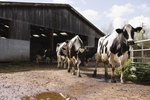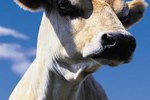Ayrshire History
Named for their county of origin -- Ayr in Scotland -- the Ayrshire was initially known as the Cunningham. The breed also was referred to as the Dunlop before it became the Ayrshire. These cattle resulted from crossing native Scottish types with imported Dutch stock. By the late 18th century, the Ayrshire was established enough to have the Highland Agricultural Society sponsor a breed show. By 1814, the Highland Agricultural Society officially recognized the breed. While early Ayrshires were black, by the early 19th century the breed was predominately red and white.
The Ayrshire utilized their native Scottish forage efficiently, producing large quantities of milk relative to grass consumption. In 1822, the first Ayrshires were imported to America, arriving in New England. It took some time, but Ayrshires eventually became accepted as a quality milk cow throughout most of the U.S.
Ayrshire Appearance
The modern Ayrshire is red and white, but the red can range from a dark, almost mahogany shade to quite light. Any color pattern is acceptable, and some Ayrshires appear nearly all red or all white. At maturity, an Ayrshire cow weighs about 1,200 pounds and stands between 50 and 53 inches high at the shoulder. While large horns were once a strong breed characteristic -- with some reaching a foot at full growth -- most Ayrshires today are dehorned as calves. Cows are renowned for their excellent udder formation.
Ayrshire Health
Ayrshires are a basically healthy breed, with strong feet and legs . Calves are especially robust and cows are known for their longevity. The U.S. Ayrshire Breeders' Association relates a publicity stunt held in 1929, when two Ayrshire cows were walked from the Ayrshire Breeders' Association headquarters in Brandon, Vermont, all the way to St. Louis, Missouri for that year's National Dairy Show. "Both cows not only survived the trip, but calved normally and went on to produce outstanding milk records for their time," notes the ABA. http://www.usayrshire.com/whyayrshire.html
Ayrshire Production
The typical Ayrshire cow produces milk consisting of 4 percent fat and 8.8 percent nonfat solids -- exceptional for cheese-making. The color is white with a yellow tinge. The milk contains tiny fat globules. The average Ayrshire cow produces about 12,000 pounds of milk annually, but the best producers in the breed might produce 20,000 pounds each year.
While Ayrshires have been replaced on commercial dairy farms -- as have most other dairy breeds -- by the ubiquitous Holstein, these cattle remain productive grazers. The ABA notes that with the modern dairy industry's focus on grazing, the breed is reviving because of the efficiency of their grass to milk conversion.
References
Writer Bio
Jane Meggitt has been a writer for more than 20 years. In addition to reporting for a major newspaper chain, she has been published in "Horse News," "Suburban Classic," "Hoof Beats," "Equine Journal" and other publications. She has a Bachelor of Arts in English from New York University and an Associate of Arts from the American Academy of Dramatics Arts, New York City.




